When people ask is if there is any specific type of food that we miss from Germany by living in the States we usually tell them that we can get almost everything here in California. And even a lot more as we love the variety of different ethnic food markets and also the abundance of local fruits and vegetables. But there is one staple in German cuisine that is hard to find here, and even when found in specialty stores and now even at Whole Foods, its quality is lacking and it is sold way overpriced: a soft cheese called “Quark”.
Quark is similar to other soft cheeses such as Fromage Blanc in that it is a white, unripened cheese. It is made without rennet and can have a variety of consistencies ranging from yogurt to dry ricotta, depending on how long the curds are allowed to drain during its preparation. Similar to Fromage Blanc, plain Quark has a much lower fat content than cream cheeses. In Germany, Quark can be bought in three different varieties: Magerquark (low fat Quark) is prepared from low fat milk, Quark is made with whole milk, and Sahnequark (cream Quark) is Quark mixed with heavy cream (4 to 1 ratio). Quark is commonly used as a breakfast spread (Quark topped with jam on a fresh oven-baked roll is a breakfast classic), for baking (e.g. in doughs or cheesecakes), and in a large variety of Quark desserts, mostly with fresh fruits.
Since we have recently started to venture into cheesemaking at home, we were highly motivated to try making our first Homemade Quark.
Before you get started, one reminder about cheesemaking: make sure to sterilize all your equipment before use, we typically rinse everything with hot water.
Pour whole milk into large cooking pot equipped with a thermometer. Slowly heat milk to 32 °C (88 °F). Remove pot from cooking stove and add 1 packet of direct set buttermilk starter. Gently mix in the starter with a cooking ladle in an up and down motion. Then cover the pot and let it sit at room temperature for 24 hours.
Sterilize butter muslin in boiling water for 5 minutes, then place it into a colander on top of another pot for draining the curds.
Cut curds with a cheese knife into large cubicles, this will help with better draining.
Transfer curds into the butter-muslin lined colander. Tie ends of butter muslin into a knot and let the curds drain for 12-24 hours, depending on the desired consistency. We have found that it works very well for us if we cover the pot again and place it into a refrigerator to allow draining for 24 hours. This way we can also prepare Quark during weekdays when we are not home during the day.
After draining you can adjust the consistency of your Quark by adding back in some of the whey, or by adding some heavy cream for a creamier taste.
Transfer quark into smaller containers for storage. We have found that it will be good for at least a week. We were very happy how our first homemade Quark turned out – although the complete process takes about two days, the actual work amount is rather minimal – and we were delighted that its taste was up to par, and probably better due to its freshness, than Quark we could buy back in Germany.
Recipe adapted from “Home Cheesemaking” by Ricki Carroll
3.8 L (1 Gallon) pasteurized milk
1 packet direct-set buttermilk starter (New England Cheesemaking Supply Company)
Heavy cream
Makes about 1.2 kg (2.6 pounds) of Quark

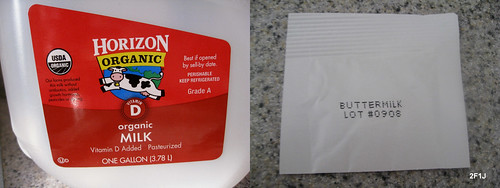
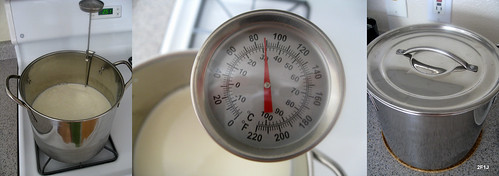

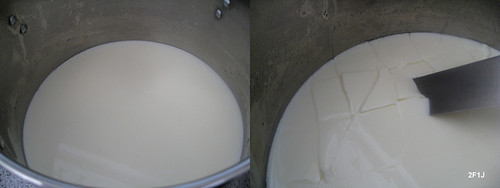

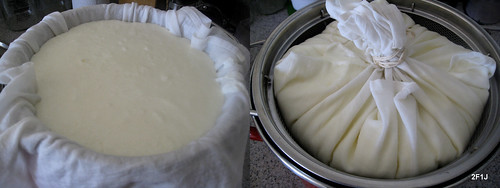

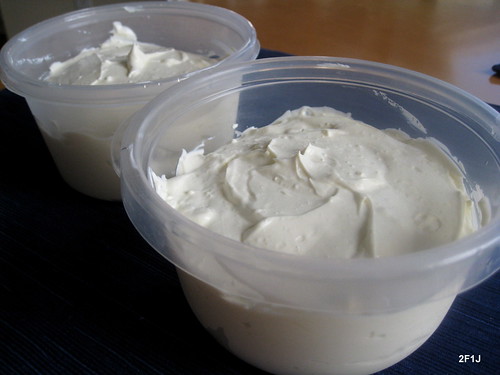





14 comments:
Looks interesting. I was very sad to miss the cheese class in my garde manger series of classes that I took.
I did notice on my recent trip to the UK that the dairy is just completely different in europe, all that rain makes for lovely sweet grass, and the dairy seems to really taste so much richer.
Jennywenny - We also often think that for example cheese in Europe has a more pronounced flavor than a similar cheese in the US.
Where did you take your garde manger classes ?
one of my dreams in kitchen has always been producing cheese. I would feel so independent producing one of the best ingredients on earth at my own kitchen ! I've done a lot of stuff from scratch like sundry meat, vanilla extract and bread but making cheese is my goal =)
thanks for inspiring me to actually do it!
raiza - Looking at your impressive blog and how much you do from scratch we have little doubt that will have a lot of success with cheesemaking. Just start with some soft cheeses to get the right feeling for making cheese.
Oh no, my blog features basically pastry stuff and it's only a month old.
I already make soft cheeses but is not very excited but thanks anyways for the advice.
raiza - Making hard cheeses are not that difficult compared to soft cheeses. The biggest challenge for us is the aging of the cheese that requires temperature and humidity control which is quite complicated in an apartment. A problem that we also face with our charcuterie efforts. There is an interesting discussion on egullet about this issue and how people use small wine cabinets
Hi - I am in the UK and it used to be common to find Quark here, but not so much now. Did you make it when you lived here and if so, what starter did you use?
Cate - When we lived in the UK we didn't make any quark but there are suppliers in the UK for cheesemaking items. You could contact for example "Moorland Cheesemakers" at www.cheesemaking.co.uk and ask them about the starter.
What do you do if you have access to the best buttermilk? Would it work if I just heated the buttermilk, let it sit, then drain? I am not sure if it has live cultures in it, but I get the buttermilk and chocolate milk from a nearby farm and it is the best buttermilk you can ask for. Any suggestions?
Cacita
Hi Foodies,
I am currently making my own Quark based on your recipe. I bought the direct-set Buttermilk from New England Cheesemaking Company. My question is : Can I set 2 gallons of milk with one package of direct-set or do I need two of them?
You would need two packages to work with two gallons of milk
Hi Foodies,
Thank you for your answer. I did use two packages and followed your steps, but my milk did not set as yours. It was more like yogurt. So, I couldn't slice it. I still tried draining it, but at the end, I end up throwing everything away. Can you suggest what I can do better? Do I need to add rennet? Thank you
It's always hard to suggest what could go wrong from far away but a few suggestion - make sure that the milk is only pasteurized not ultra pasturized otherwise it won't work. If you haven't done it you should try to use a thermometer to make sure to reach the correct temperature. And when you try it again make sure to sterilize everything be rinsing with very hot water. Hopefully your next try will work. Please let us know if we can help in any other way
Thanks for creating this wonderful post :)
Post a Comment